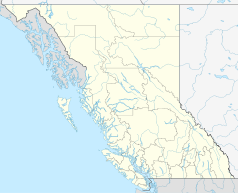Courtenay (British Columbia)
| Courtenay | ||
|---|---|---|
 In the center of Courtenay |
||
| Location in British Columbia | ||
|
|
||
| State : |
|
|
| Province : | British Columbia | |
| Regional District : | Comox Valley Regional District | |
| Coordinates : | 49 ° 41 ′ N , 124 ° 59 ′ W | |
| Height : | 13 m | |
| Area : | 32.41 km² | |
| Residents : | 25,599 (as of 2016) | |
| Population density : | 789.8 inhabitants / km² | |
| Time zone : | Pacific Time ( UTC − 8 ) | |
| Postal code : | V9J, VJN | |
| Foundation : | 1915 ( incorporated ) | |
| Mayor : | Bob Wells | |
Courtenay is a city on the east coast of Vancouver Island . It is located in the province of British Columbia in Canada . It is the largest city in the Comox Valley and the administrative seat of the Comox Valley Regional District .
history
Courtenay has officially existed since January 1, 1915 . The city was named after the Courtenay River , which in turn was named after George William Courtenay , captain of HMS Constance , which was anchored in this area between 1846 and 1849. However, the history of the area and its inhabitants goes back further. Before the arrival of the first European settlers, the area was already a settlement and hunting area of the First Nation , mainly the K'ómoks .
On June 23, 1946, the community was shaken by the Vancouver Island earthquake , which shook the island with a magnitude of 7.3. It was the strongest earthquake on the island to date and had its epicenter on the Forbidden Plateau , about 30 km east of Courtenay.
geography
Courtenay is 4 km west of Comox , 7 km northeast of Cumberland , 5 km northwest of Royston and 108 km northwest of Nanaimo . According to Canadian statistics, the city has an area of around 29 km². Highway 19 runs through the urban area of Courtenay . The city is located in the northern area of the Esquimalt and Nanaimo Railway line .
Demographics
The last official census , the 2016 Census , showed a population of 25,599 inhabitants for the settlement, after the 2011 census still showed a population of 24,099 inhabitants for the municipality. The population increased by 5.7% compared to the last census in 2011 and developed in line with the provincial average, there with a population increase of 5.6%. In the census period from 2006 to 2011, the number of inhabitants in the municipality increased by 9.4%, while the provincial average increased by 7.0%.
At the 2016 census, the average age of the residents was 45.8 years, well above the provincial average of 42.3 years. The median age of the residents was determined to be 48.3 years. The median age of all residents in the province in 2016 was 43.0 years. For the 2011 census, a median age of 46.5 years was determined for the inhabitants of the municipality, and 41.9 years for the inhabitants of the province.
In the 2001 census, around 10% of the population were immigrants. Among the immigrants, the Chinese were by far the largest group of the population, ahead of other groups from Asia.
education
Courtenay is part of School District # 71 - Comox Valley , which is based in Courtenay. There are various schools in the city; including seven elementary schools and four secondary schools as well as the North Island College .
politics
The city was granted municipal self-government on January 1, 1915 ( incorporated as a City municipality ).
The borough mayor is Bob Wells. Together with six other citizens, he forms the council of the city (council).
economy
The main industries in Courtenay are retail, tourism and the supporting industries, and education and health / social care. Fisheries as well as agriculture and forestry only play a subordinate role.
The median income of Courtenay workers in 2005 was C $ 22,662, while at the same time the average for the entire province of British Columbia was C $ 24,867. The income gap between men (C $ 30,975) and women (C $ 16,832) is in line with normal provincial proportions.
Web links
- Courtenay ( English, French ) In: The Canadian Encyclopedia .
- City of Courtenay
- Courtenay on britishcolumbia.com (Engl.)
Individual evidence
- ^ A b Courtenay Community Profile. Census 2016. In: Statistics Canada . August 9, 2019, accessed September 4, 2019 .
- ^ Andrew Scott: The Encyclopedia of Raincoast Place Names: A Complete Reference to Coastal British Columbia . Harbor Publishing, Madeira Park, BC 2009, ISBN 978-1-55017-484-7 , pp. 136 (English).
- ↑ The M7.3 Vancouver Island Earthquake of 1946. Natural Resources Canada , March 11, 2019, accessed August 25, 2020 .
- ^ Courtenay Community Profile. Census 2011. In: Statistics Canada . May 31, 2016, accessed September 4, 2019 .
- ^ Schools. (No longer available online.) School District # 71 - Comox Valley, archived from the original on Nov. 6, 2012 ; accessed on January 10, 2013 .
- ^ Origin Notes and History. Courtenay. GeoBC , accessed January 10, 2013 .
- ↑ City website: Mayor & Council. City of Courtenay, accessed March 11, 2019 .
- ^ Courtenay Community Facts. BCStats , accessed January 10, 2013 .
